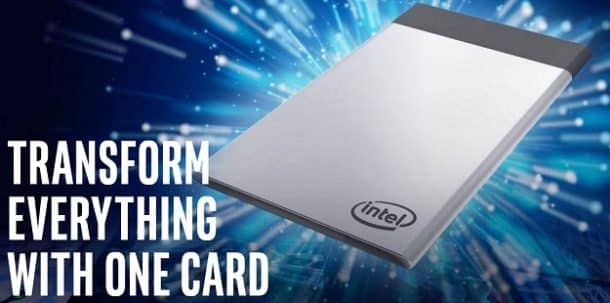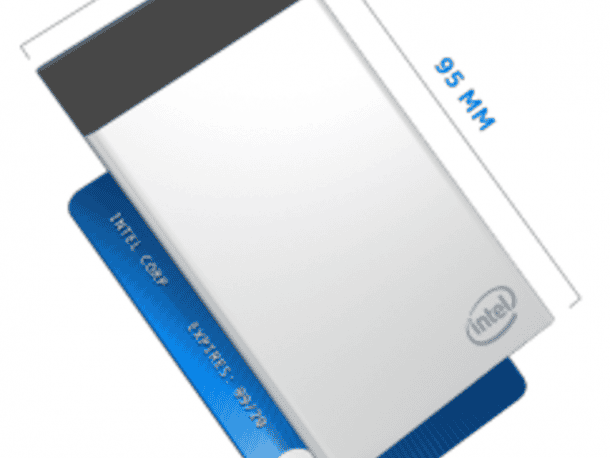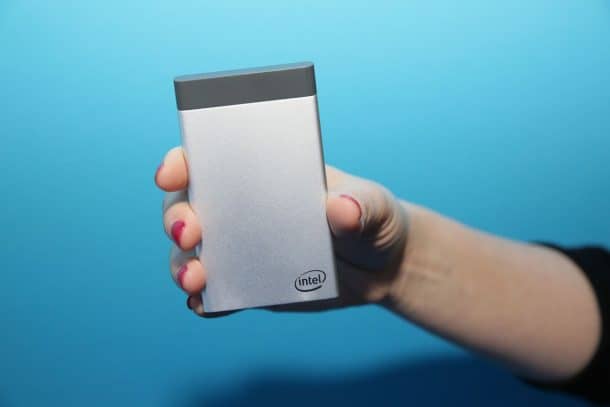Remember those big CPUs and fat monitors? Beginning with those space-consuming computer systems, we have now come to tiny smartphones with unlimited functionality. Even though a smartphone can virtually do anything that a desktop PC can, it still lacks some of the capabilities. Laptops have grown as small as 7 inches, but it is still not as portable as a phone. Intel is packing your desktop into a credit card-sized Pocket PC. Does it get any better than carrying your PC around in your pocket?

Intel created the NUC, a small box with the power of a PC and now they have a gone a level higher with the world’s tiniest computer, the Intel Compute Card. The tiny space of the Compute Card holds a notebook-class Core i5 processors, 4GB of RAM, 128 GB flash storage, 802.11 Wi-Fi, and Bluetooth 4.2 connectivity. Turning your PC into the most portable device you can imagine. The Compute Card measures 95mm in length and 55mm in width with a thickness of only 5mm.

The gadget was unveiled at the CES this year, but the company later announced the Compute Card Device Design Kit at the Computex 2017 Technology Expo, which is meant as a blueprint for PC manufacturers so that they can produce modular computing products enhancing the capabilities of the Pocket PC.
Intel has also announced a tiny desktop PC shell with USB ports HDMI, DisplayPort, and Ethernet connectivity. You can plug your Compute Card in the shell, and your fully functional desktop PC is ready to go.
Intel says that the Compute Card will offer endless possibilities. “Companies will be able to extend capabilities for devices such as digital signage and kiosks, All-in-Ones, smart TV’s and appliances – all while reaping the benefits that modular computing can offer, such as simplifying inventory management and serviceability.” Intel believes the product to be a transformation that will bring “the power of computing and connectivity to any product, anywhere.”

The expected release of the Pocket PC is August 2017 and depending on the model that you choose, the prices are expected to vary between $140 and $450. The slim and sleek PC will be easy to install and maintain.

Other companies have begun to explore the potential of the Compute Card. LG is working on a large display that becomes a PC when the card is inserted, Seneca is looking into using it for powering a digital media player, Sharp is looking at an intelligent display device with an embedded Pocket PC. The gadget is just a modular PC that can turn any compatible device into a full-fledged computer system.
Foxconn, the company that builds the devices for companies the likes of Apple and Dell, is exploring a thin convertible laptop powered by the Compute Card. The produced a prototype monitor that turns into a PC when the card is inserted. We are looking into a future when the traditional desktop PCs and even laptops will become extinct, and your PC upgrades will require nothing but a card change.
As exciting as the technology may look, its success is entirely dependent on the interest of manufacturers. HP, Dell, and Foxconn appear to be enthusiastic about it, but we will only know for sure when the device actually starts to ship. Intel will need to provide support for the new card for at least a few years.
Apart from our daily personal and work lives, the gadget is expected to transform the education industry as well. If it could be used with the low low-cost Chromebook-like laptops, children could be allowed a free hand with the systems. Instead of dealing with the hassle of using separate systems at work, home or school, you will be able to switch the same card between laptops, screens, and what not.
Are you one of those people super excited by the technology? Or do you think it is just another gadget that won’t do well in the real world?


